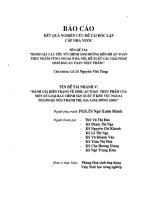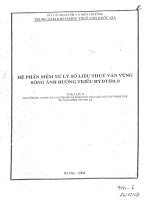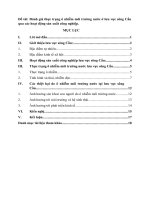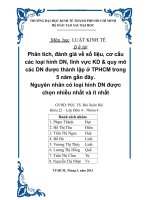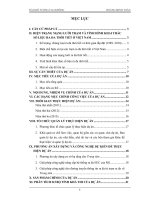Xuất khẩu gia công phần mềm ở Ireland
Bạn đang xem bản rút gọn của tài liệu. Xem và tải ngay bản đầy đủ của tài liệu tại đây (173.25 KB, 11 trang )
Skills for business enquiry
What will be the long-term impact of
offshoring on Ireland’s IT workforce?
Words: 3481
I.
Overview
IT offshoring is considered necessary for companies across the globe to achieve economic
effectiveness and is becoming an irreversible trend. However, IT offshoring is also regarded as
one of the most critical issues of the early 2000s as it causes concern about job loss (Carmel and
Tjia, 2007).While across Europe the demand for ICT worker is now outstripping the supply and
will significantly increase by 2020 (Hüsing et al., 2013),paradoxically, European programmers
are losing their jobs. There is a prediction that UK will lose 150.000 jobs due to IT
offshoring(Carmel and Tjia, 2007). This triggers a need of research into the implications of IT
offshoring in Ireland to Irish IT workforce.
Within the Irish marketplace there exists a strong culture of outsourcing with IT managed
services and web hosting being among the most common activities outsourced.This high
demandoriginates from economic benefits that outsourcing brings: 92% of organizations believe
that outsourcing adds value to their company(Mazars, 2011).
A recent report from EGFSN indicates that the strong demand for high-level ICT skills such as
IT management, planning and consultancy will continue to grow while the number of computer
science graduates is expected grow only slightly over the next 6 years (EGFSN, 2013).This
suggests that Ireland’s IT offshoring activities have already had implications on its IT workforce,
which poses a need of research to confirm or reject the hypothesis.
.Over 6-years experience as an IT graduate and software engineer in international software
companies, Tung has a tacit knowledge of the managerial aspects of IT offshoring. The research
topic is deeply rooted in his background and interest.
A graduate of Commerce in UCC,Eolan has experience in both research projects and experience
as a recruitment coordinator for a technology company in 3 rd year placement which peaked his
own interest in the subject and offered a constructive environment for learning. Through this
Eolan has had an inside look at IT workforce and the distribution of employment.
II.
Literature Review
1. Trends in IT offshoring & IT human resource in Ireland
The general prediction is that outsourcing in Ireland will continue to increase (Mazars, 2011). A
high percentage of large Irish organizationsare benefited from advantages that outsourcing brings
such as: Relief of internal resources to concentrate on core function, reduction of costs, access to
skills and knowledge that was not available internally and enhanced process efficiency and
Research proposal
Page 1
Skills for business enquiry
quality. Furthermore, there is a the possibility of saving through outsourcing furthering the ROI,
encouraging managers to further adopt the practice(Mazars, 2011).
Although outsourcing causes some concerns such as job loss, wage decline and military threat,
political backslash has little effect on trend of outsourcing(Carmel and Tjia, 2007). A survey
from (Mazars, 2011)also shows that manager decisions on outsourcing are not affected by
economic downturn. 42% of respondents indicated that they had increased their use of
outsourcing in the preceding 12 months as compared to 33% in 2010. 25% of companies
indicated that they would increase their use of outsourcing over the next 12 months (Figure 1).
Figure 1: Outsourcing trends(Mazars, 2011)
The results from EGFSN's study indicate that Ireland is likely to face a significant annual
increase in demand for high-level ICT skills of around 5% in the next 6 years. Paradoxically, the
number of Irish ICT graduate in computer science and is predicted to increase only slightly by
2016 and then fluctuating by 2018 (EGFSN, 2013).It leads to a hypothesis that IT offshoring
activitiesresults in high demand for high-level ICT skills and at the same time reduces the
demand for lower level ICT skills.
2. Method of researching into IT Offshoring
(Tambe and Hitt, 2010) did a large scale research on the effect of IT offshoring on US’ IT labor.
Their finding is based on two surveys conducted in 2007;the first researched in the offshoring
practices of 3,016 individual firms to discover factors such as whether and why these firms
offshore, as well as what types of work and to what countries they offshore. The second survey
was targeted to 6704 individual workers to discover whether or not they had been displaced due
to offshore.
The purpose of the two surveys is to test hypotheses that the offshoring rates for workers in IT
industry differs significantly from the rates in other occupations, and that jobs which require
face-to-face contact with US-based consumers or co-workers or require to perform hands-on
work with US-based assets are less likely to be offshored.
Quantitative method is the research method used in the paper. Some statistical hypothesis testing
practices used in the research are: Finding correlations between occupation and reasons for
offshoring chi-squared test of the hypothesis of equality between displacement rates for IT and
non-IT workers, probit analysis for offshore job types etc.
Although the research was conducted in large scale, the fact that quantitative method is the only
method in this research poses some concerns due to the fact that IT offshoring domain should be
addressed in cultural and social context.
III.
Research Question
1 The question
The main purpose of this research is to answerthis question:
What will be the long-term impact of outsourcing on Irelands IT workforce?
Research proposal
Page 2
Skills for business enquiry
3. The question’s value
Research into this question isinteresting and worthwhile in the sense that it provides sources
forIrish government's policy adjustment in human resource and in education system to address
the negative implications of IT offshoring.
4. Viability
In the context of the iBusiness program, this research is viable due to a number of reasons: The
relevant knowledge and background of the authors, the relationships of the authors with some IT
outsourcing companies and the availability of figures and statistics of Ireland's ICT workforce.
5. Difficulty
Notwithstanding, researching into IT Offshoring faces some hurdles: Managers from both host
companies and recruiting companies prefer containing information about IT Offshoring due to
social backlash (Carmel and Tjia, 2007). As a result, collecting enough information for the
research is not an easy task. Furthermore, most discussion on IT offshoring relies on anecdotes,
press reports and theoretical arguments, and most researches on this topic depends on subjective
answers to questionnaire(Tambe and Hitt, 2010). To achieve good result demands meticulous
analyzing of the data.
Research proposal
Page 3
Skills for business enquiry
IV.
Research Design
1 Mixed research method
As graduates coming from Computer Science and Commerce background, we are familiar with
quantitative research method. Applying quantitative research practices – conducting structured
survey and analyzing available statistics – in our case, is relatively quick, economical and useful
for studying large number of people. These advantages meet the scope of this course, making it
the first choice in our research.
However, we also understand the disadvantages of quantitative method, such as the result of
quantitative research are limited as they only provide numerical accounts which generally
provide less elaborate description of human perception. As suggested by (Orlikowski and
Baroudi, 1991), researchers should ensure that they adopt a perspective that is compatible with
their own research interest while remaining open to the possibility of other assumptions and
interests. In our context, researching into IT offshoring demands an elaborate look at social and
cultural aspects and a meticulous analysis of qualitative data rather and numerical ones.
Considering the scope of the course and the appropriateness of research methods in the context
of IT offshoring, we choose a mixed approach to conduct our research. Mixed method has some
advantages such as “triangulation” – different practices and procedures of collecting and
analyzing data will both enrich and confirm the picture of the situation, “complementary” –
elaborating, enhancing and illustrating the results from one method with the results from another.
The choice of mixed method partly explains our choice of research practices which will be
described later in this paper.
6. Exclusion of case study research
Although we want to do a careful case study of an Irish company adopting IT offshoring, it is not
feasible in the context of IT offshoring. The reason is that, companies are generally concerned
about the public relation fallout and as a result containing the information about IT offshoring as
much as possible (Carmel and Tjia, 2007).
7. Secondary research
a. Reason
There are a large number of available materials about IT outsourcing and IT labor in Ireland.
Researching into the body of knowledge in the research domain potentially provides directions
and overview of the research.
Research proposal
Page 4
Skills for business enquiry
b. Papers to look at
We will focus mainly on papers in the followingtwo categories:
•
Mixed research method
To exploit the advantages of mixed research method, we decided to spend time to research into it
to know how to apply it effectively. “Research methods for business students ” by (Saunders et
al., 2009) and “Business research methods” by (Greener, 2008) is a useful textbook to help us
obtain the essential points of the research method. Furthermore, to see an example of applying
this method in practice, we will consult the paper “Mixing Methods: The Entry of Qualitative
and Quantitative Approaches into the Research Process” by (Brannen, 2005).
•
Research practices for IT Offshoring
We chose an empirical study conducted by (Tambe and Hitt, 2010)on IT offshoring in the US as
a core piece of our secondary:“How offshoring affects IT workers?”. The paper examines the
growth of IT outsourcing and how it affects, in the long term, the domestic IT sector. The
importance of this study for us is that it helps us develop a framework for identifying and
analyzing changing organizational needs such as training. It also allowed us to develop opinions
on how policy makers can affect an international IT workforce.
The article raises some interesting questions we have to consider when presenting our own
research proposal, such as we have to acknowledge the difference in scale between America and
Ireland. Furthermore, we know that our research will have to adapt to deal with the laws that
affect offshoring in IT, and how the various Irish environmental factors affect such as low
corporate tax rate, access to Europe and the knowledge base economy will alter our findings.
•
Other materials
IT Offshoring is a broad research area whichrequires profound knowledge of cultural and social
factors involved in IT Offshoring activities. We are aware that the success of the project depends
on our ability and commitment to research more into these factors. To achieve this, we will need
to read some materials: “Offshoring Information Technology: Sourcing and Outsourcing to a
Global Workforce” (Carmel and Tjia, 2007) which provides economic, politic and management
considerations; some reports such as “Addressing Future Demand for High-Level ICT Skills”by
(EGFSN, 2013)and “e-Leadership: e-Skills for Competitiveness and Innovation Vision,
Roadmap and Foresight Scenarios” by (Hüsing et al., 2013) to have more broad view of IT
labor’s status quo in Ireland and in Euro.
Research proposal
Page 5
Skills for business enquiry
c. Technique
The techniques we used in secondary research will follow the paper “A Systems Approach to
Conduct an Effective Literature Review in Support of. Information Systems Research” by (Levy
and Ellis, 2006).
d. Expected result
We expect to have an overview of the status quo of Ireland’s IT labor and IT offshoring and
more clear direction after the secondary research.
8. Survey
a Reason
Although we can obtain statistics from Central Statistic Office (CSC), there is no guarantee that
we can request all information we need or information in the form we. We insist on conducting a
survey due to the fact that we can validate the status quo of the firms to which we send the
survey, hence ensuring the consistency and accuracy of data. Furthermore, the survey is ideal in
that it can measure many variables without increasing the potential cost of time. Data can be
gathered from surveys at a low cost and quickly relative to the design or the issue of the survey.
e. Subjects
The subjects of the survey are both companies and individuals. The list in
contains over 160 notable Irish
companies operating in various sectorscan serve as the start point to find the contact to send
survey. However, offshoring activites do not exist only in medium and big firms, but also in
small firms. Therefore, we must exploit our experience and relationship with other Irish firms to
collect more contact. For this type of survey, we should target the hiring managers or HR
profession who has significant importance in hiring decisions because they are the gateway that
information of offshoring activities must go through.
We suggest using LinkedInto collect individuals’contact, focusing on Irish IT labor. The survey
must record the status of respondants such as their age, type of work and their workplacement
under the effect of IT offshoring. The detailed and final survey are only available after a careful
secondary research and analysis of available statistics which will give us prelimirary focused
point to target at.
f. Technique
This research is conducted via e-mailing a questionnaire to respondents, who then administer the
survey themselves. The central concern for this survey is the response rate, even an attractive
questionnaire that is clear and concise needs additional attention to maximise the response rate.
Research proposal
Page 6
Skills for business enquiry
A response rate of less than 70% is not ideal as this would call into question the
representativeness of the survey. Although the size of our samples is small, we will try to choose
representative samples i.e. companies from small to big, in various sectors; individuals from
different ages etc. Using such stratery will possible generate findings that are representative of
the whole population.
To eliminate any confusion we would be specific with our questions and if asked a ‘Why’
question, it would be followed up by a sub-question to ensure validity. According to (Lazarsfeld,
1935)the use of the ‘why’ question in market research is a source of misinformation unless
phrased carefully and should preferably be supplemented with follow up questions.
g. Expected result
At the end of this phase we expect to have quantitative data which suggests possible reasons for
particular relationships between variables and which can be analysed quantitatively using
descriptive and inferential statistics.
9. Analyzing data from Central Statistics Office
a Reason
Our statistics would be drawn from the central Statistics office as they have conducted much
research into our area of interest and have worthwhile information relating to the facts and the
trends. Furthermore, the CSO meets the government criteria for quality statistical information at
the regional and local levels. They provide impartial and unbiased data on social and economic
conductions. They pay particular attention to the specialist needs of the research and academic
community for more focused research and data.
In 2010 the CSO invested heavily in IT with the installation of a Data Management System and
upgraded their statistical analysis software to SAS enterprise Business Intelligence(Central
Statistics Office, 2010). These investments would assist our research in providing the most upto-date information on the trends of business.
h. Sources
The detailed plan of what data to look at is only available after the secondary research. However,
follows are some of types of data we are looking for, if available:
•
•
•
•
Firms’ size and industries
Number of abroad employee
Salary for them
Number of unemployment in IT labor in recent years
Research proposal
Page 7
Skills for business enquiry
i. Technique
For our analysis of the statistics we would use a numerical computing environment called
MATLABwhich allows for compression of massive amounts of statistics in easily digestible
graphs and information.
j. Expected Result
We want to see the trend of IT offshoring in Ireland, the status quo of Irish IT laborand some
possible correlations between them.
10.Interview
a Reason
The qualitative research interview seeks to describe and the meanings of central themes in the
life world of the subjects. The main task in interviewing is to understand the meaning of what the
interviewees say (Kvale and Brinkmann, 2007).The interview seeks to find out answers on a
more meaning level than a questionnaire. This interview is a much more personal experience
than a question as the interviewer works with the respondent. Unlike our survey, the interview
offers the opportunity to probe and ask follow up questions.
k. Subjects
Our interview would draw from several sources. Initially we would like to speak to the people
responsible for the decisions that result in outsourcing, the executives and managers in charge of
plants with the potential for outsourcing. For example, Intel or HP in Leixlip would present the
perfect opportunity to conduct the interviews. Although firmly embedded in Ireland, these
organisations are constantly under threat of outsourcing as their operations expand along with
global skills.
We would also look to multinational organisations that have recently moved to Ireland, we
would seek to find out their reasons for coming here. Organisations such as Google, Twitter and
Facebook have established European headquarters in Ireland.
The interview would need to be organised through official chains of communication. Making
contact first with the HR department and establishing who the best potential interviewee is. Once
established organising a time and a place to suit the interviewee and make them feel comfortable
is the next step.
l. Technique
In conducting interviews, ethical issues are one of the main concerns. Confidentiality must be
given. Respondents “should not be harmed or damaged in any way by the research … It is also
Research proposal
Page 8
Skills for business enquiry
important that interviews are not used as a devious means of selling something to the
respondent” (Gray, 2009).
It is the role of the researcher to ask questions. The questions ought to elicit valid response from
respondents. (Hoyle et al., 2002)comment that questions have “ … dual goals of motivating the
respondent to give full and precise replies while avoiding biases stemming from social
desirability, conformity, or other constructs of disinterest.”
We will conduct the interview in an informal and conversational method. The interviewer would
only ask a few predetermined questions in order to remain as open and adaptable as possible to
the nature and priorities of the interviewee, we feel this would allow for the most scope and
potential for relevant information.
A good interview will get the respondents involved in the process as early as possible. The
interview should begin with questions about some facts and intersperse these questions
throughout the interview. The interviewee should focus on the present before turning to the past
or the future. The end of the interview should allow respondents to provide any other
information.
m. Expected result
We would expect a different outlook than in the survey, as an interviewee is much more
susceptible to emotions than a questionnaire respondent.
In terms of manufacturing industries such as Intel, with a higher propensity for outsourcing, we
would have difficulty separating fact from opinion. The interviewee may feel they will damage
the reputation of their employer if negative facts are given, hence not be privy to the information
that may be relevant to the questions.Also, their judgments may be affected by their own
attachment; their confidence in the operation may be far from the reality. However,we do not
doubt that the interview would lead to be very valuable results especially in terms of the past and
present.
This interview would be balance by an interview with a knowledge based business such as
Facebook or Twitter who have only recently moved to Ireland. These interviews would seek to
find the motivations behind these locations and also the propensity for these organisations to
move country. Weagain feel that the employees would be wary of damaging company reputation
but the potential damage would be softened by the fact they have only recently moved here and
thus wouldn’t move again for many years.
Research proposal
Page 9
Skills for business enquiry
V.
Research Planning
With the choice of research methods and practices described in IV.Research Design, we
proposed the following time table for the research:
Table 1: Research time table
Time
December 2013 March 2014
1st April 2014 15th April 2014
Tasks
Aim / Comments
Obtain more knowledge
Secondary research
Requesting statistics
data from Central
Statistics Office
Design survey
Find focused point to research intoand to know
how to design survey
Sending the survey out as soon as possible
Spreading the survey
16th April 2014 June 2014
Analysis of available
statistics from Central
Statistics Office
July 2014 September 2014
Fieldwork1st:
Interview
October 2014 November 2014
Analysis of data from
fieldwork1st
December 2014 February 2014
Fieldwork2nd: Followup Interview
March 2014 June 2014
Research proposal
Work on thesis
Find more focused point to research into and to
know how to design interview
Find more detailed view of organizations toward
IT offshoring
Gathering data from the organizations
Gain more insight
Get data from more focused interview
Analyse data to confirm or reject hypothesis
made in previous phases
Synthesize all statistics and knowledge from
Literature review, survey, data from Central
Statistic Office, and 2 interviews
Page 10
Skills for business enquiry
Reference
BRANNEN, J. 2005. Mixing Methods: The Entry of Qualitative and Quantitative Approaches
into the Research Process. International Journal of Social Research Methodology.
CARMEL, E. & TJIA, P. 2007. Offshoring Information Technology: Sourcing and Outsourcing to
a Global Workforce, Cambridge University Press.
CENTRAL STATISTICS OFFICE. 2010. IT strategy 2010-2012 [Online]. Available:
.
EGFSN 2013. Addressing Future Demand for High-Level ICT Skills. Ireland: Forfás.
GRAY, E. D. 2009. Doing Research in the Real World.
GREENER, S. 2008. Business Research Methods, Venrus Publishing ApS.
HOYLE, R. H., J., H. M. & JUDD, C. M. 2002. Research methods in social relations. London:
Thomson Learning.
HÜSING, T., KORTE, W. B., FONSTAD, N., LANVIN, B., WELSUM , D. S. E. V., CATTANEO, G.,
KOLDING, M. & LIFONTI, R. 2013. e-Leadership: e-Skills for Competitiveness and
Innovation Vision, Roadmap and Foresight Scenarios. Ireland: Empirica.
KVALE, S. & BRINKMANN, S. 2007. InterViews: Learning the Craft of Qualitative Research
Interviewing.
LAZARSFELD, P. F. 1935. The Art of Asking why in Marketing Research: Three Principles
Underlying the Formulation of Questionnaires.
LEVY, Y. & ELLIS, T. J. A Systems Approach to Conduct an Effective Literature Review in Support
of. Information Systems Research. Informing Science Journal, 2006.
MAZARS 2011. Mazars Annual Outsourcing Survey 2011. Ireland: Mazars Ireland.
ORLIKOWSKI, W. J. & BAROUDI, J. J. Studying information technology in organizations:
Research approaches and assumptions. Information Systems Research, 1991.
SAUNDERS, M., LEWIS, P. & THORNHILL, A. 2009. Research Methods for Business Students,
Pearson Education Limited.
TAMBE, P. B. & HITT, L. M. 2010. How offshoring affects IT workers. Communications of the
ACM, 53, 62-70.
Research proposal
Page 11
